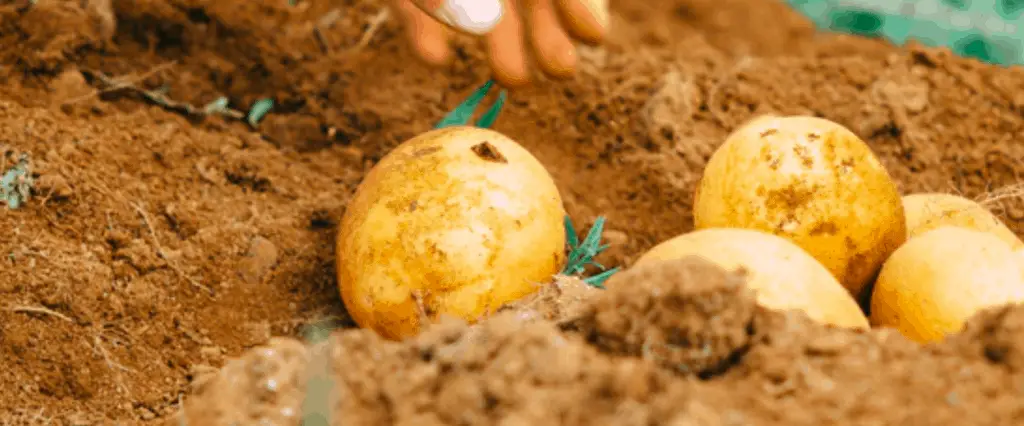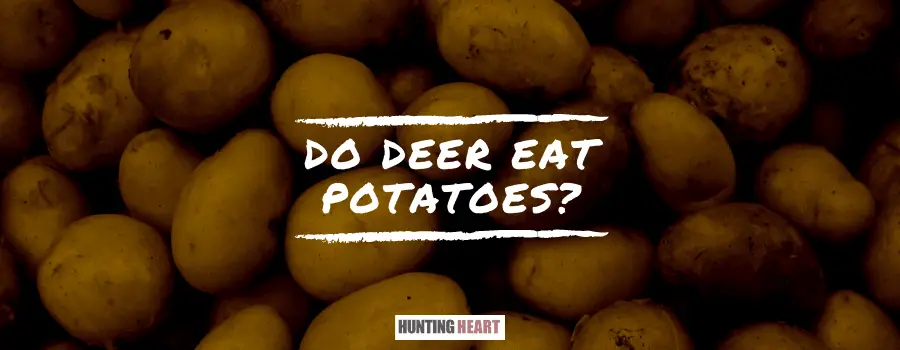As an Amazon Associate I earn from qualifying purchases.
Our Associate portal can be found here
Gardening is a calling; one that we dedicate a lot of time and resources to so we can harvest a delectable crop. But something is eating at your spuds, and with the presence of wildlife critters in your area, you’re wondering; do deer eat potatoes?
Deer eat potatoes and depending on the type. Whitetails and mule deer in particular will actively wage war on your crop. This varmint doesn’t prefer food it has to dig up, but it’ll eat taters that are available above ground. As part of the nightshade family, potato vine’s leaves are poisonous to ruminants, but they’ll nibble at young shoots or hoof out the tuber when it’s below the ground.
Your potatoes or young shoots of the plant are in danger where deer proliferate. In some spud-rich areas, this varmint has developed quite a taste for potato tubers. Let’s look at what you can do to protect your taters from these four-legged pests.
How Are Deer Able To Digest Potato Tubers?
If the environment around where you live allows you to propagate various garden vegetables successfully, you’re very lucky. The opportunities for a stellar crop of potatoes are ever-present, but your spud patch seems to be attracting deer. Well, the ungulate is a ruminant, meaning they can go through most plants and digest them using fermentation.

So, do deer eat potatoes, or are they coming around for something else? They do, and they’re possibly lingering around because there’s little to consume elsewhere. They have been known to dig out spuds from the soil; even stuffing themselves to the point of acidosis and death.
Unlike your monogastric stomach arrangement, meaning it has one chamber, deer have four sections. Tough to digest fibrous plants and woody leaves are initially chewed and stored in the first compartment. A rumination process occurs when they’re at rest. The stowed chow is regurgitated, chewed, and swallowed to the next digestion stage.
In the first stomach chamber, aptly called the rumen, digestion begins, initiated by secreted natural digestive bacteria. Ruminate or regurgitate cud is fermented to break fibrous and woody material into amino acids before being re-chewed for efficient nutrition extraction. To better understand deer affinity for potatoes, let’s look at how ruminant herbivores are classified.
Are Potatoes a Preference for Deer or Food They Turn To In Dire Situations?
Deer eat potatoes, and they’ll also nibble on your spud plants when they’re young, essentially dashing any hopes of a crop. Their food choice suits what’s available, and they can switch from browsing to scavenging tubers leftover from farm harvests.
Classification of ruminant feeding patterns dictates how deer feed depending on the species and the time of year. These herbivores are categorized as concentrate selectors, intermediate feeders, and roughage grazers.
Sheep and cattle are roughage grazers as they eat mainly grass, which stays longer inside the rumen. On the other hand, deer feed on small amounts of everything but frequently and browse plants with high cell content. As intermediate feeders, they can also graze like cows.
Besides the foods that deer will run to eat, such as certain fruits, nuts, and mushrooms, deer will nibble at other plants to see how they taste. A garden like yours is a candy store for this critter, and potatoes possibly represent licorice, hard on the mouth but an acquired taste nonetheless.
How Can You Protect Your Potato Crop from Invading Deer?
If you’ve planted some potatoes, it’s worth considering making them deer-proof, at least until you can haul in a harvest. Many options claim to be the best varmint deterrent, but as a hunter cum gardener, I can tell you that none is certain since you are dealing with adaptable wildlife.

Where deer develop a taste for taters, it’s only a matter of time before they get used to sounding noises, lights, mid-height hedges, and all the scarecrows you can throw at them. Such options include taste-based repellents, electric fences, mechanical obstruction, and spray scents.
I would think it’s not an ideal tactic to let the varmint take a bite of your spuds and sample its taste, but it may deter deer from returning. In my opinion, smell-based repellents work best as the scent hits the sharp-nosed Bambi while still at a distance. The great news is you can make a stink-bomb using beef, eggs, soap, chilies, and urine, not yours but that of a natural deer predator.
Outside of an eternally howling mongrel, lion, coyote, bobcat, bear, and even wolf urine sprays are available in hunting stores or online. When sprayed on or around a potato crop, deer will be turned away, thinking a predator is lying in wait behind the plants.
Human hair also retains the people’s smell that game animals fear and avoid. You can strategically hang balls of this readily available beauty parlor or barber shop by-product around your spud patch to repel deer.
Can You Deter Deer from Your Potato Patch with Other Plants They Dislike?
Your vegetable garden in an area where deer are populous can be an uphill task, but the plants you grow can act as natural repellants. When planted among or around your potato garden, such crops will have Bambi thinking the entire fare is tainted. These include;
- Strong smelling and tasting plants like garlic, onions, leeks, dill, mint, and chives will disgust deer. The varmint also avoids spicy crops, including parsley, asparagus, lemon balm, tarragon, basil, lavender, thyme, and rosemary.
- Prickly stalked plants with fuzzy, hairy leaves, including pumpkins, cucumbers, and squash varieties.
- Nightshade species related to potatoes, such as peppers and eggplants or the leaves of cucumber and rhubarb, are poisonous to deer.
Which Crops Bring Deer to Your Potato Garden?
You aim to keep deer from visiting your garden so they don’t discover your crop of potatoes. As such, avoid plants that attract the pests and make them leave grass and other foliage to visit your tubers.

These include beans, broccoli, peas, cabbage, strawberries, turnips, spinach or kales, and sweet potatoes. Nuts and fruit are probable deer magnets, and they’ll climb over fences for acorns, pecans, hickory, blueberries, apples, persimmons, and blackberries.
On many hunting grounds, you’ll find hunters baiting this game animal with sweet taters, which is illegal but still practiced. The varmint also has a preference for Brussel sprouts, corn, bok choy, and cilantro. Another favorite of white-tailed deer is tomatoes, whether green or ripe red.
Once discovered in your garden, carrots will also call the hoofed visitors from their usual haunts. Don’t be surprised when they dig up your entire crop.
Conclusion
You’ll find deer feasting on your crop of potatoes, but there are ways you can keep them out of your garden. Chances are these critters are very hungry, and you can incorporate plants they dislike within your patch of taters. As a rule, feeding these wild animals with your leftover harvest only leads them to develop a taste for spuds, one you’ll be hard-pressed to satisfy.
Other plants of the potato subspecies don’t fare well against deer. Sweet potatoes taste like candy to the varmint, and they’ll go to great lengths to retrieve them. Beets, radishes, and winter squash will have their tops and tubers eaten down by the ungulate, especially when hungry or craving nutrients.
Amazon and the Amazon logo are trademarks of Amazon.com, Inc, or its affiliates.

36 years old, been hunting and fishing my entire life – love the outdoors, family, and all kinds of hunting and fishing! I have spent thousands of hours hunting hogs and training hunting dogs, but I’m always learning new stuff and really happy to be sharing them with you! hit me up with an email in the contact form if you have any questions.



